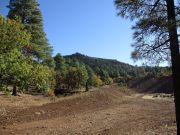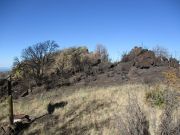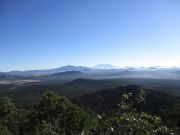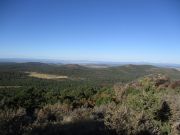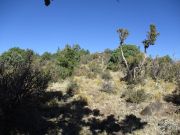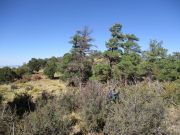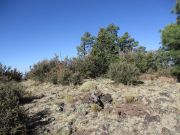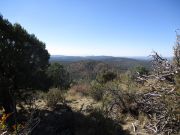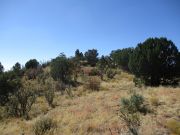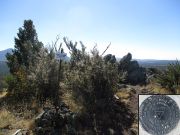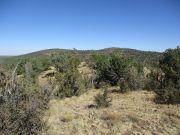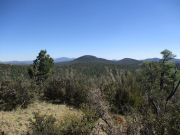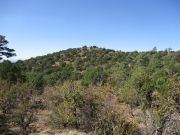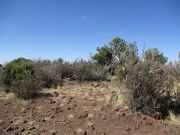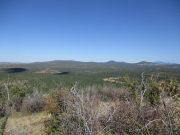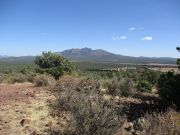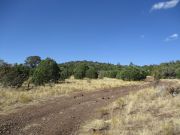
The Mountains of Arizona
www.surgent.net |
|
Three Sisters Peak • Hearst Mountain These four peaks lie on the western edge of the San Francisco Volcanic Field, northwest and west of Williams. The first three lie in a clump northwest of the city, while Snyder Knoll lies west. All four are covered in forest (ponderosa, juniper, gambel oak, mahogany), but open enough so that views are not completely blocked. Matthias and I were confident we could visit the trio northwest of Williams in just a few hours, so we had a few back-up peaks in mind in case we had the extra time, which we did, which is why Snyder Knoll got corralled in with this grouping. The weather has been warmer than normal throughout the state, but today would be the first day of a 20-degree cool-down, so that lows would be in the low 50s and highs in the low 70s. The sky was clear, there was no humidity, and there was a breeze that ranged from gentle and calm to heavy and strong as the day wore on. Conditions were fantastic, the best weather in the world right about now. We met at Denny's on the Carefree Highway at 5 a.m., and drove up through Prescott's outskirts to catch AZ-89 to Ash Fork, then eastbound on Interstate-40 to Williams, arriving to the general area about 7:20 a.m..
Date: October 22, 2023
• Elevation: 7,644 feet
• Prominence: 684 feet
• Distance: 1.5 miles
• Time: 70 minutes
• Gain: 687 feet
• Conditions: Blue skies, cool temps, absolutely stunning
• Teammate: Matthias Stender
• Prog-rock bands played: Frank Zappa, Soft Machine, La Bocca della Verita
Arizona
•
Main
•
PB
•
LoJ
•
USGS BM Datasheet
•
Interactive map
We exited on to Country Club Drive, followed it under the railroad tracks, and passed through a bunch of homes and a golf course, the "ritzy" part of Williams. The road goes west a little then bends north, losing the pavement, now back on Kaibab Forest land.
We wanted a small track that dead ends at a cinder pit. We found this road. There were lots of people camping — not just a car and a tent, but RVs with tables set up, coolers everywhere, and ATVs. It's hunting season now, all the hunters are out now. But for now, it was all still and quiet.
We parked at the cinder pit, starting our hike about 7:40. It was cool, about 55°, and very comfortable. Looking up, we could see Three Sisters Peak through the clearing. The Three Sisters are three humps of the same mountain, better seen from the Williams side, as from here, we were just viewing the biggest sister. There was a large rock knob at the peak's west tip, while the summit, according to the map, was on the east tip.
Once past the cinder pit, the hiking was easy but tedious, the forest being thick, with smaller trees clogging up the spaces between the bigger ones. We got about halfway up and found a ribbon tied to a tree branch. Then another up ahead. With nothing to lose, we decided to follow these ribbons as far as they would go, as long as it seemed to take us upward.
It turns out the ribbons (and some cairns) marked a very scant path that did lead upward, placing us at the base of the top ridge's western rock knob. We clambered through one easy tier of rocks and were soon on this top ridge and past the rocks. This "trail" led to a couple solar-powered antenna apparati, function uncertain. This path was clearly put in by, and for the benefit of, the antenna guys. We thank them. It made our ascent quite easy.
The top was just a few more yards east, through rocks and branchy thickets. The summit is a ridge of rocks forming cliffs about 10 feet tall facing north and east. The top rocks could be any of about a half dozen contenders, so we tagged and kicked each one. We found a register placed by Bob Burd less than a month ago and signed in. Surprisingly, someone else was here just a couple days ago and she had signed in as well.
The views were tremendous. Looking east, we could see many dozens of the cinder peaks on the San Francisco Volcanic Field, along with might Humphreys Peak, Sitgreaves Mountain, and Kendrick Peak partially hidden behind Sitgreaves. The forest service was doing some prescribed burns, and the smoke hung low to the ground, forming "misty" effects between the hills. I am sure air quality wasn't great, but it sure looked pretty.
We took a few minutes to rest up here. We looked for the benchmark but could not find it (it has been removed). We signed into the register too, and took our time before starting down. We followed the ribbons down as far as they went, then cut through the trees and back to the cinder pit, and back to Matthias' vehicle, the round trip hike taking a little over an hour. We were happy to get one done, and pleased it went well, especially finding that path, which probably saved us twenty minutes of branch-pushing-and-breaking otherwise.
Elevation: 7,395 feet
• Prominence: 375 feet
• Distance: 1.5 miles
• Time: 50 minutes
• Gain: 384 feet
• Conditions: Beautiful
PB •
LoJ
Hearst Mountain was next. It lies west of Three Sisters, just a couple of miles away. The map shows "Hearst Mountain" written across two peaks. For references here, this higher summit is named "Hearst Mountain" and the lower summit to the south that hold a USGS benchmak is called "Hearst Benchmark".
We got back on the main road, went south a little bit, then turned onto a secondary track south of Holden Lake. This track heads southwest. Remember, road numbers printed on the maps don't match what's listed on the signs in the field. Some Game and Fish law enforcement guys were questioning some campers in an RV just off the road, probably just verifying tags and permits.
We followed this road about a quarter-mile, then a hard right onto a road that goes northwest. These roads are shown on the forest service maps. This last road just dead ends below Hearst Mountain's summit. We'd drive it as far as a road junction about a quarter-mile before the road's end. These roads weren't bad. My Subaru Forester could have handled them. The area has been freshly logged so the roads have been recently graded, which may explain why the roads were in decent condition.
We parked off the road and started walking, aiming for the low point of a ridge above us, southeast of the peak. Massive piles of logs and branches lined the roads, some piles about 20 feet tall. What they do with these piles, I don't know.
On the ridge, we just marched northwesterly for a little over a half mile until we topped out. The forest was not as thick here and we had open views the whole way, greatly simplifying navigation. We were on the summit in twenty minutes. This had been an easy hike.
The top is broad and a cairn is at or near the highpoint. We walked around, kicking any other possible highpoint rocks to be sure. The register held names going back many years, almost all of them hunters. Bob Burd was here last month and then that same person who was on Three Sisters a couple days ago was also here.
We didn't spend long, and retraced our route down and back to Matthias' car, our total time gone about 45 minutes. Hearst Mountain, the southern of the two Hearst peaks, was close by, and we'd be there in a matter of minutes.
Elevation: 7,226 feet
• Prominence: 306 feet
• Distance: 0.8 mile
• Time: 50 minutes
• Gain: 326 feet
• Conditions: Breezier
PB •
LoJ
•
USGS BM Datasheet
We drove a scanter track south toward the peak, parking off the road on the peak's east slope. Any place looked like a good place to start. We had to cross over a fence early on.
The trees were thick down low, a lot of gambel oak. They were turning yellow and orange, which was pretty to view, but they would sometimes grow in dense clumps. Once past them, we walked uphill toward a rock heap, then up past that, a gentler slope to the top ... or so we thought. We had ascended the lower of the two summit bumps. It was just a minute or two to get over to the higher, southern summit.
This summit features a rock heap and a benchmark, which we found in one of the lower-set rocks. A sign nearby mentioned there being a geodetic survey marker here. I'm surprised that sign was here because it's not really necessary, and that it's still here after all these years.
The register held many names, and like before, most were hunters. Then Bob a month ago, then the lady from a few days ago, then us. We had fantastic views, but the breeze was stronger now, in the 15-20 m.p.h range. We spent about ten minutes up here. The best view, in my opinion, was that of Bill Williams Mountain, immediately to the south of us.
We hiked down the same way, more or less. It was still not yet noon when we were back to the car. These three peaks had gone well with no trouble whatsoever. We didn't want to head back so early, so we decided to drive over and give Snyder Knoll a look.
Elevation: 6,968 feet
• Prominence: 388 feet
• Distance: 2.3 mile
• Time: 75 minutes
• Gain: 428 feet
• Conditions: Spotty clouds, breezy, but still brilliant
PB •
LoJ
Back on Interstate-40 westbound, we exited at the Devil Dog exit, about five miles down the hill from Williams. This is just a tiny exit that accesses a small reservoir adjacent to the interstate, and a portion of the original Route-66 that still exists as a frontage road. It's also an access point into the Kaibab National Forest; in particular, a starting (or ending) point of the Bill Williams Mountain Scenic Loop Drive.
Snyder Knoll is a very spread-out hill rising about two miles south of the interstate, covered in forest. You could be excused for not noticing it if driving by, as it is not obvious at all. Only expert map readers and experienced mountaineers know of its existence.
We went south a little bit to Old Route-66, then westish back toward the interstate, then left onto a haggard dirt track that went south, then bent west to parallel the interstate, at times within about 50 feet of it. The dirt road wasn't the greatest. It was very uneven with potholes and some rocks. My Subaru would not have done well on it. Matthias' 4-Runner did better due to its better clearance and beefier tires/suspension. The road then bends south, crosses through a meadow where the knoll can be seen, and continues south up a gently-inclined canyon. Our plan was to park roughly due-east of the summit and bust directly through the trees to it. From where we parked, the summit was just a half-mile west of us, about 400 feet higher.
We entered into the trees then onto the slopes, generally tracking southwest and angling upslope, working through the tangly brush and limbs. It wasn't the prettiest forest ever. I was in the lead and breaking trail, aiming for a peaklet ahead of me, assuming it to be the summit. When we got most of the way up its slope and looked back, the true summit was visible more to the northwest. We, meaning I, had overshot the peak.
Fortunately, this was a minor error, costing us just a few hundred extra feet of walking and maybe 10 minutes of time. We had more open terrain now and made good time to the top. And right as we approached its top, there's a road! This was not expected.
The top is brushy and rocky, and we walked around the area to tag all the contenders. We were not able to find a register. The one-way hike had taken us about 35 minutes and covered about three-quarters of a mile. We spent about ten minutes up top, looking around. Some clouds had rolled in, one or two blocking the sun, as the breeze picked up. But it was warmer here than where we had been, now being about 500 feet lower in elevation.
We got on to our devices and looked at the satellite maps and sure enough, there was the road. We saw where it connected to and determined it would take us back to the car, albeit adding an extra mile possibly to the hike. But we were okay with that because we could walk fast on a road rather than deal with brush and crud. Neither of us knew there was a road to this peak's top. Had we known that, we would have at least driven closer to shave off time. The top half of the road is steep and rocky and would require 4-wheel drive.
The walk back took about a half hour, but was an easy walk requiring no thinking. We were happy to be successful on this unheralded peak. It's not one either of us, or anyone, would come all this way for, but as an add-on bonus peak, it was perfect. And to its credit, views from the top were pretty good. This is the western lip of the San Francisco Volcanic Field. Looking west, the land drops about a thousand feet into grassy rangeland country.
It was close to 2 p.m. now, and we had four peaks now in the books. We started the drive back south along AZ-89 toward Chino Valley and Prescott. This 40-mile stretch of AZ-89 from the interstate to Chino Valley is two-lane all the way with no passing lanes, and it can get crowded, as it did today. Some guy dragging a boat was going 50 m.p.h. and creating a backlog of about 15 cars behind him, us being about 5th. You know what that means: everyone starts passing every chance they get, cutting in line, and so on.
We had a fifth peak in mind, Rock Knoll, which rises west of the highway south of Hell Canyon. So we bailed out of this car backlog and went to look at it. If we got lucky and the roads got ridiculously close, we'd go for it. Well, the roads are decent, but we decided not to bother. But now we know about it and the road's condition. Back on AZ-89, we were home free into Chino Valley, where we got snacks before the long push back to Phoenix, arriving about 6 p.m..
Today had gone well, with four easy peaks, and great weather. We split gear and said our goodbyes, and got moving. I stopped in at my local favorite Greek/Mediterranean place for some shawarma.
|
|
